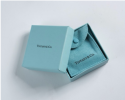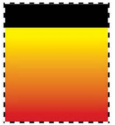- HOME
- > Blog Main Page
- > Colorful Possibilities in the Wake of In re: Forney
Colorful Possibilities in the Wake of In re: Forney
by Katie Anderson
On April 8, 2020, the Court of Appeals for the Federal Circuit held in In re: Forney Industries Inc.,[1] that multi-colored marks on product packaging could be inherently distinctive, effectively providing another possible registering method for those wishing to register color marks.
Color Marks
A person who is gifted a robin-egg blue jewelry box is likely aware that the product inside is from Tiffany & Co. Likewise, a person who reaches for the red-soled high-heels in a shoe store is likely aware she is buying a product from Christian Louboutin.
In this way, Tiffany & Co. and Christian Louboutin are using color to “identify and distinguish [their] goods . . . from those manufactured or sold by others and to indicate the source of the goods . . . .”[2] The colors are thus, trademarkable.
This was confirmed in Qualitex Co. v. Jacobson Products Co., [3] when Qualitex, a supply company, was able to prove that the green-gold colored dry-cleaning pads it sold helped consumers determine that the dry-cleaning pads came from Qualitex and not from a different cleaning company. The U.S. Supreme Court held that “there is no rule absolutely barring the use of color alone” as a mark.[4]
Inherently Distinctive versus Secondary Meaning
In In re: Forney, Forney Industries, a company that sells welding tools, applied to register the color mark found on all of its products’ packaging. The mark “consists of a solid black stripe at the top. Below the solid black stripe is the color yellow which fades into the color red.”[5]
Forney Industries applied to the Principal Register, which requires applicants to either have marks that are inherently distinctive or provide evidence of a secondary meaning, which means the applicants have to show that the mark has acquired distinctiveness. In other words, over time consumers have come to see the mark and know that it distinguishes the product as belonging to a particular manufacturer.
For example, the first time Tiffany & Co. used a robin-egg blue box to package its jewelry, consumers may not have found the color inherently distinctive, but Tiffany & Co. could show that over time, the color has certainly gained a secondary meaning.
Forney Industries did not submit any evidence of secondary meaning and instead relied on the fact its color mark was inherently distinctive. The examining attorney at the USPTO denied the application and the Trademark Trial and Appeal Board affirmed the denial, stating that as a matter of law, color marks could not be inherently distinctive. Forney appealed to the Court of Appeals for the Federal Circuit.
Product Design versus Product Packaging
Trademarks can be “any word, name, symbol, or device, or any combination thereof.”[6] In Two Pesos, Inc. v. Taco Cabana, Inc., [7] the U.S. Supreme Court concluded that trade dress fell under the purposefully unrestricting categories of “symbol[s]” or “device[s].”
Trade dress can be a brand’s aesthetic as a whole (such as a company’s restaurants’ layouts, decor, and server uniforms, as in Two Pesos) or a feature of a product (such as the flowery designs found on the shirts of a children’s clothing line in Wal-Mart Stores, Inc. v. Samara Brothers, Inc.[8]).
The Supreme Court, in Two Pesos, further concluded that trade dress can be inherently distinctive.
Qualitex later held that color, as a form of trade dress, could be used as a trademark, “where that color has attained secondary meaning.”[9]
In 2000, in Wal-Mart, the U.S. Supreme Court noted that the trademark category of trade dress has two subcategories: product design (marks on on the product itself), and product packaging (marks placed on the packaging that the product is distributed in).[10]
Wal-Mart also stated that color marks could never be inherently distinctive.
Because of these three Supreme Court cases, since 2000, applicants registering color marks on the Principal Register knew that whether or not their color mark was on the product design or the product packaging, they had to submit evidence of secondary meaning because while color alone could be trademarked, it could not be inherently distinctive.
In re: Forney’s New Take on Color Trademarks
2020 – Enter In re: Forney. The Court of Appeals for the Federal Circuit interpreted the rule in Qualitex as not saying color marks need evidence of a secondary meaning, but that they may need it.[11]
Also, the Court found the statements in Wal-Mart to be merely “guideposts,” as opposed to rules that color could not be inherently distinctive.[12]
The Court further noted that in Wal-Mart, the type of mark at issue was a product design mark. Consequently, the Court stated that the correct rule to be extracted from Wal-Mart is actually that only product design color marks could not be inherently distinctive, but that product packaging color marks still could be.
The Federal Circuit thus held that as a matter of law, color marks on product packaging could be inherently distinctive.
One Last Caveat: Single-colored Marks versus Multi-colored Marks
In 2016, the Court of Appeals for the Tenth Circuit made a ruling on a Forney Industry color mark in Forney Industries, Inc. v. Daco of Missouri, Inc.[13] The mark was very similar to the one in In re: Forney. The main difference between the marks is that the mark in Daco was described in more detail on its application.
The Tenth Circuit held that the color mark on the product packaging was not inherently distinct because the multiple colors of the mark were not “used in combination with a well-defined shape, pattern, or other distinctive design.”[14] Essentially, the Court held that if an applicant is registering a mark that has multiple colors, then the colors must form together to create some design for the mark to possibly be deemed inherently distinctive.
As a result, it seems there may be even further distinctions in color mark law, separating single-color marks from multi-color marks.
In In re: Forney, however, the Federal Circuit ruled that multi-colored marks do not need a distinctive “peripheral shape or border,” to be inherently distinctive, seemingly doing away with Daco’s rule that multi-colored marks require a “well-defined shape.”[15]
Going Forward
After In re: Forney, applicants can now apply a colored mark to the Principal Register without providing evidence of a secondary meaning, if the color mark is on the product packaging and is inherently distinct. If the mark is made up of multiple colors, to pass as inherently distinct, it is helpful if the colors make up a well-defined shape, but not strictly necessary.
This narrow allowance could have a wider implication for product manufacturers who have not yet accumulated a large consumer following but have created a unique product packaging through the use of color. These applicants would no longer be restricted to either waiting until their packaging has acquired a secondary meaning or applying to the Supplemental Register.
Likewise, applicants without a large consumer following may have an easier time registering color marks to the Principal Register if they place the color marks on the product packaging, as opposed to the product design. So, take a page out of Tiffany & Co.’s book and place that robin-egg blue on the jewelry packaging and not on the jewelry itself!
Will this rule stick?
Only time will tell. With the Tenth Circuit ruling that the colors of a Forney Industries color mark need to be in a “well-defined shape,” while the Federal Circuit ruled that an extremely similar color mark’s colors need not, it is possible that the U.S. government will claim that there is a split among the circuits regarding the law of color marks and petition to the U.S. Supreme Court for certiorari.
References
[1] In re: Forney Indus. Inc., 955 F.3d 940, 942 (Fed. Cir. 2020).
[2] 15 U.S.C. § 1127 (2018).
[3] Qualitex Co. v. Jacobson Prods. Co., 514 U.S. 159, 161 (1995).
[4] Id. at 162.
[5] 955 F.3d at 943.
[6] 15 U.S.C. § 1127.
[7] Two Pesos, Inc. v. Taco Cabana, Inc., 505 U.S. 763, 770 (1992).
[8] Wal-Mart Stores, Inc. v. Samara Brothers, Inc., 529 U.S. 205, 207 (2000).
[9] 514 U.S. at 163.
[10] 529 U.S. at 212.
[11] 955 F.3d at 946.
[12] Id.
[13] Forney Indus., Inc. v. Daco of Missouri Inc., 835 F.3d 1238, 1248 (10th Cir. 2016).
[14] Id.
[15] In re: Forney Indus. Inc., 955 F.3d at 947; Daco of Missouri Inc, 835 F.3d at 1248.

TAGS:
RECENT POSTS
